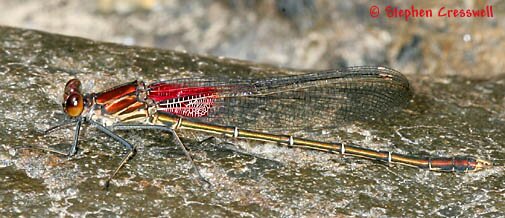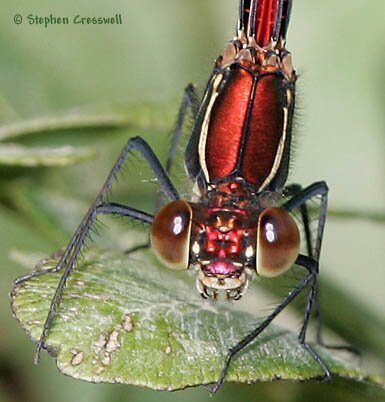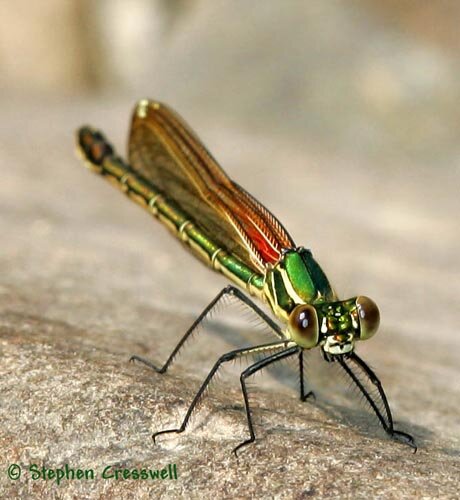 This beautiful damsel is difficult to mistake for any other species in our area. If you have a damselfly with a brightly colored thorax and a bright red spot at the base of the wings, you have an American Rubyspot.
This beautiful damsel is difficult to mistake for any other species in our area. If you have a damselfly with a brightly colored thorax and a bright red spot at the base of the wings, you have an American Rubyspot.Family: Calopterygidae
Length: 39-46 mm
 This beautiful damsel is difficult to mistake for any other species in our area. If you have a damselfly with a brightly colored thorax and a bright red spot at the base of the wings, you have an American Rubyspot.
This beautiful damsel is difficult to mistake for any other species in our area. If you have a damselfly with a brightly colored thorax and a bright red spot at the base of the wings, you have an American Rubyspot.
Males usually have a bright metallic red thorax, with creamy colored striping. Occasionally the male's coloration is more of a reddish bronze than bright red. Females have metallic green thoraxes, or else bronzy green.
The spot at the base of the wings is usually bright red in the male. Females may have a red spot too, but more often their spot is a subtle amber.
Don't hang around ponds looking for this one. While occasionally found at large lakes, the species most typical habitat is a sunny riverbank. You will find the American Rubyspots perched on plants along the bank, or on rocks in the river itself.
One of the nice things about American Rubyspots is that they have a long flight season, at least June to September in West Virginia and possibly earlier and later as well.

Duke University professor Clifford Johnson (1961) described territorial behavior by male Hetaerina americana. When a perched male sees another male flying into his territory, "He flies directly toward the intruder, which then avoids the resident male by flying in a small circle." The resident male pursues, and the two form an ever-widening circle. Eventual one male breaks off and flies away, while the victor gives chase for a short distance and then returns to the same perch or one nearby.
Johnson noted that the territories last only one day. If a male returns to the area the following day it may choose the same perch, or one a short distance away, or one that is on a more distant section of the river bank.
Duke University professor Clifford Johnson (1961) described courtship and mating in Hetaerina americana. When a female appears in a male's territory the male attempts to perch on the female's thorax. If she is receptive she flies into the male's territory and hovers. The male quickly flies to her and clamps the tip of his abdomen onto the her prothorax, and the pair flies in tandem to a nearby perch. Other males may respond to the tandem pair with aggression, even forcing them to separate.
When the tandem pair is safely perched, the female soon curves her abdomen toward the male's external genitalia and the pair form the wheel position, typically maintaining this position for 3-4 minutes. After breaking from the wheel, the pair rests for a few minutes, then flies in tandem to an oviposition site. Usually the male perches on vegetation growing in the water and walks backwards toward the water until the female is fully submerged. The female oviposits on the underwater plants while the male performs guard duty, driving off even large insects like Anax junius that stray too near. Males guard for up to 40 minutes. Interestingly, Johnson noted that "Despite many hours of observation I have never seen a female return to the surface." He concluded that either the females remain submerged for a very long time or else they emerge downstream from where they enter. Surely many are victims of predation or the strong currents.
Another of Johnsons interesting observations was that, if the couple is separated at any time in the courtship or mating, the entire process must start again from the beginningthey seemingly cannot just pick up where they left off.
Five years later, Johnsons study of Hetaerina americana mating was supplemented by that of Bick and Sulzbach (1966). They confirmed many of Johnsons observations. They also added that when they observed ovipositing females, they had invariably seen the female surface once again, 7-52 minutes later.
McCafferty (1979) reported seeing some 200 Hetaerina americana perched on river rocks at dusk in Indiana, flying up repeatedly to capture emerging mayflies, then return to the rocks to eat them.
 |
|
The female American Rubyspot replaces the male's reds with bright green or bronzy green. This coloration is not only on the thorax, but on the dorsal surface of the abdomen as well. On this individual, the spot on the base of the wings is more amber than red. Note how much thicker the female's abdomen is, compared with that of the male (see top photo on this page). |
 |
|
This female American Rubyspot has brilliant metallic green coloration on the face and thorax and on the top of the abdomen. It also sports a bright red spot at the base of its wings, and white stigmas. |


